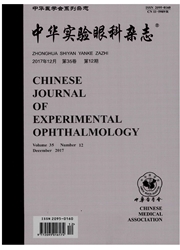

 中文摘要:
中文摘要:
背景 米诺环素在多种中枢神经系统疾病的动物模型及临床试验中显示出神经保护效应,但是否对视神经损伤有保护作用研究尚少. 目的 探讨米诺环素在小鼠视神经钳夹伤后对视网膜神经节细胞(RGCs)的保护作用及其作用机制.方法 采用随机数字表法将136只清洁级雄性C57BL/6J小鼠随机分成正常对照组8只、生理盐水组64只和米诺环素组64只.正常对照组不做任何处理,生理盐水组和米诺环素组用反向镊钳夹小鼠左眼视神经3s以建立视神经钳夹伤动物模型,造模后米诺环素组立即以45 mg/(kg·d)的剂量腹腔内注射米诺环素0.4ml,造模后24 h注射剂量减半,以后每日注射1次,直至处死,生理盐水组小鼠以同样的方式注射等容量的生理盐水.两组小鼠分别于造模后第4、7、11、14天处死并制备视网膜铺片,用4',6'-二脒基-2-苯基吲哚(DAPI)染色法观察各组小鼠RGCs层细胞密度的变化.取各时间点小鼠眼球制作视网膜冰冻切片,采用TUNEL法测定RGCs的凋亡;采用实时定量PCR(real-time PCR)法检测各组小鼠视网膜小胶质细胞表面CD11b mRNA的表达.结果 在视神经损伤后第4天和第7天,生理盐水组小鼠RGCs层的细胞密度分别为(77.50±2.38)个/0.01 mm2和(70.00±2.94)个/0.01 mm2,明显低于米诺环素组的(88.75±2.36)个/0.01 mm2和(81.00±3.92)个/0.01 mm2,差异均有统计学意义(t4d=-6.708,P<0.01;t7d=-4.491,P<0.01);生理盐水组RGCs凋亡数分别为(12±1)个/mm和(4±1)个/mm,明显多于米诺环素组的(4±1)个/mm和(1±0)个/mm,差异均有统计学意义(t4d=12.832,P<0.01;t7d=3.455,P=0.026);造模后第11天和第14天,生理盐水组小鼠RGCs层的细胞密度与米诺环素组比较差异均无统计学意义(P=0.708、0.777),且两组小鼠视网膜均未发现凋亡细胞.Real-time PCR检测显示,造模后第4天和第7天,生理盐水组小鼠视网膜细胞CD11b mRNA
 英文摘要:
英文摘要:
Background Minocycline possesses neuroprotective effect in a variety of animal models and clinical trials of central nervous system,but whether it works on optic nerve injury remains unclear.Objective This study aimed to observe the protective effects of minocycline on retinal ganglion cells (RGCs) in the early stage of optic nerve crush and explore its mechanism.Methods One hundred and thirty-six clean C57BL/6J mice were randomly divided into normal control group,normal saline solution group and minocycline group.The optic nerve crush injury models were induced in the left eyes of the mice in the normal saline solution group and minocycline group by a cross-action forceps for 3 seconds.Minocycline was injected intraperitoneally in the minocycline group firstly 45 mg/kg(0.4 ml) and followed by 22.5 mg/kg per day after 24 hours until sacrifice of the animals,and the equivalent volume of normal saline solution was injected in the same way in the normal saline solution group.The mice were euthanized at 4,7,11,14 days postoperatively and the left eyeballs were collected.Retinal flat mounts and DAPI staining was used to observe and compare the change of RGCs density among different groups and various time points.Apoptosis of mice RGCs were assessed by TdT-mediated dUTP nick end labeling (TUNEL).Real-time polymerase chain reaction (real-time PCR) was used to detect the expression of CD11b mRNA in retinal microglials.Results DAPI staining in retinal flat mounts showed that the average RGCs density was (77.50±2.38)/0.01 mm2 and (70.00±2.94) /0.01 mm2 in the 4th and 7th day after modeling in the normal saline solution group,and those in the minocycline group were (88.75 ± 2.36) /0.01 mm2 and (81.00 ± 3.92)/0.01 mm2,with significant differences between the two groups (t4d =-6.708,P〈0.01 ;t7d =--4.491,P〈0.01).The apoptotic RGCs were (12±1)/mm and (4±1)/mm in the normal saline solution,which were significantly more than (4±1)/mm and (1±0)/mm in the minocycline g
 同期刊论文项目
同期刊论文项目
 同项目期刊论文
同项目期刊论文
 期刊信息
期刊信息
